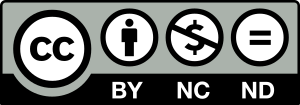As mentioned earlier, one of the basic parameters for knowledge to be considered open is that it is published under an open license or a public domain declaration. In the case of the former, these types of licenses allow information to be redistributed and reused with few restrictions.[1] In other words, open licenses indicate to a person or organization that the content can be used under certain conditions established by the author and the type of open license used. On the other hand, information published under a public domain declaration can be used and exploited freely, without any permission,[2] while respecting the author's integrity. This tool allows the creator of a work to waive their copyright and place it in the public domain. Both terms are embedded within open access, making information more useful by allowing a greater number of people to make use of it.[3]
To delve deeper into open licenses, it must be mentioned that there are a variety of them; however, the most well-known and widely used are those offered by Creative Commons, an international nonprofit organization that seeks to share technical, legal, and policy solutions to benefit the exchange of knowledge.[4] Creative Commons open licenses allow the use of a work but under certain conditions, ensuring that the content remains protected. In other words, if an author wishes to post their work on the internet to reach a wider audience, they can use one of these licenses, which must be attached to their work so that the public can identify the usage conditions chosen by the author when accessing the open content.[5]
There are six types of open licenses, which are presented in the following table:
| Name | Description | Symbol |
|---|---|---|
| Attribution - by (CC BY) | Allows people or organizations to perform any exploitation of the work, whether through reuse, distribution, adaptation, and development of the material in any medium or format, as long as attribution is given to the author. This license allows commercial use. | |
| BY: credit must be given to the author. | ||
| Attribution - Share Alike (CC BY-SA) | Allows the commercial use of the work and its derivatives. This license allows reusers to remix, adapt, and develop the material in any medium or format, giving attribution to the author. Derivative works must be distributed under the same license as the original work, meaning under identical terms CC BY-SA. | |
| BY: credit must be given to the author. | ||
| SA: adaptations must be shared under the same terms as the original work | ||
| Attribution - Non-Commercial (CC BY-NC) | Allows the distribution, adaptation, and development of the work as long as it is not for commercial purposes and attribution is given to the creator. The creation of derivative works from the original is permitted as long as they are not for commercial purposes. | |
| BY: credit must be given to the author. | ||
| NC: only non-commercial uses of the work are permitted. | ||
| Attribution - Non-Commercial - Share Alike (CC BY-NC-SA) | Allows the distribution, adaptation, and development of the work only for non-commercial purposes and as long as attribution is given to the author. Distribution of derivative works from the original must also be non-commercial and under a license identical to that which governs the original work. | |
| BY: credit must be given to the author. | ||
| NC: only non-commercial uses of the work are permitted. | ||
| SA: adaptations must be shared under the same terms as the original work. | ||
| Attribution - No Derivatives (CC BY-ND) | Allows people or organizations to copy and distribute the work, as long as attribution is given to the author and no derivative works are created from the original. This license allows commercial use. | |
| BY: credit must be given to the author. | ||
| ND: no derivatives or adaptations of the work are allowed. | ||
| Attribution - Non-Commercial - No Derivatives (CC BY-NC-ND) | Allows the copying and distribution of the work only for non-commercial purposes and in an unadapted form, meaning no derivative works can be made from the original. Attribution must be given to the author. | |
| BY: credit must be given to the author. | ||
| NC: only non-commercial uses of the work are permitted. | ||
| ND: no derivatives or adaptations of the work are allowed. | ||
| Source: Own elaboration based on information compiled from "About CC Licenses", Creative Commons, accessed September 2023, https://creativecommons.org/share-your-work/cclicenses/ | ||
- ↑ "Open Licenses", Universidad Politécnica de Cartagena, accessed September 13, 2023, https://biblioguias.upct.es/licencias-abiertas
- ↑ "Works in the Public Domain", Library of the University of Seville, accessed September 13, 2023, https://bib.us.es/estudia_e_investiga/investigacion/propiedad/dominio
- ↑ Peter Suber, Open access (Cambridge: MIT Press, 2012), 6. https://nrs.harvard.edu/urn-3:HUL.%20InstRepos:10752204
- ↑ "Who we are", Creative Commons, accessed September 14, 2023, https://creativecommons.org/mission/
- ↑ "Open Licenses: Creative Commons and GPL", University of Alicante, accessed September 14, 2023, https://biblioteca.ua.es/es/investiga-y-publica/pi/licencias-abiertas-creative-commons-y-gpl.html





